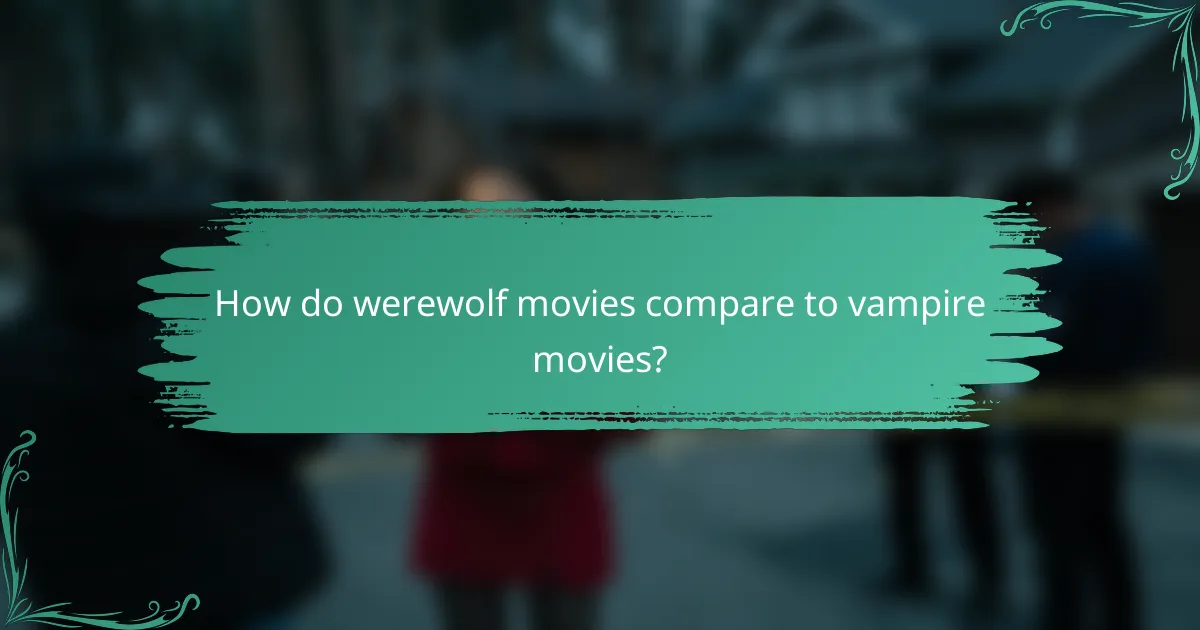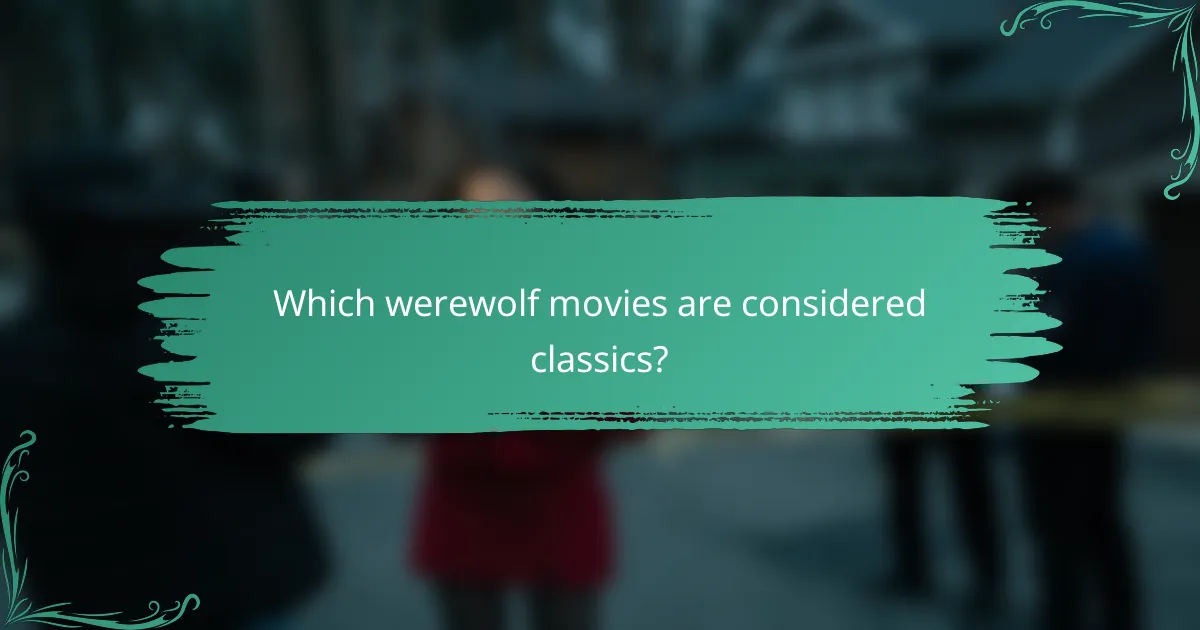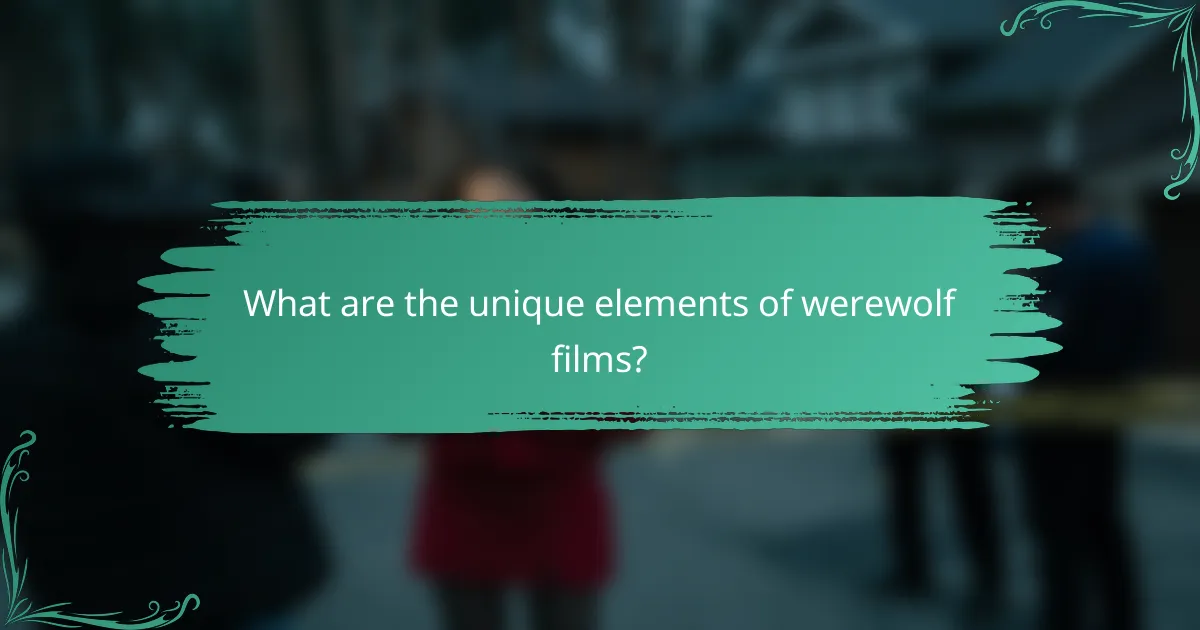Werewolf movies stand out in the horror genre by delving into themes of transformation and the internal battle between humanity and primal instincts. Unlike vampire films, which often emphasize immortality and seduction, werewolf narratives focus on identity, control, and the duality of human nature. This unique perspective not only shapes character development but also enriches the storytelling within the broader context of horror cinema.

How do werewolf movies compare to vampire movies?
Werewolf movies often focus on themes of transformation and the struggle between humanity and primal instincts, while vampire films typically explore immortality and seduction. Both subgenres share horror elements but differ significantly in their narrative focus and character development.
Distinct themes and lore
The themes in werewolf movies often revolve around the loss of control and the duality of human nature, where characters grapple with their animalistic side. In contrast, vampire movies frequently delve into themes of eternal life, power dynamics, and the allure of the forbidden. The lore surrounding werewolves is often tied to folklore and curses, while vampires are rooted in mythology and romanticism.
Character transformations
In werewolf films, transformations are usually depicted as painful and involuntary, symbolizing the struggle against one’s darker impulses. This physical metamorphosis can serve as a metaphor for personal struggles, such as addiction or mental illness. Vampire transformations, however, are often portrayed as seductive and voluntary, representing a choice between life and death, or morality and immortality.
Audience reception

What are the defining characteristics of werewolf movies?
Werewolf movies are characterized by their exploration of transformation, mythology, and the duality of human nature. They often depict the struggle between man and beast, highlighting themes of identity, control, and primal instincts.
Transformation sequences
Transformation sequences are a hallmark of werewolf films, showcasing the physical change from human to wolf. These scenes often involve dramatic special effects, emphasizing pain and struggle, which can range from quick, intense transformations to slow, agonizing ones. Classic examples include the iconic transformations in “An American Werewolf in London” and “The Howling.”
When creating or analyzing werewolf films, consider the impact of the transformation on character development and plot progression. Effective transformations can evoke empathy and fear, making them pivotal moments in the narrative.
Full moon mythology
The full moon is a central element in werewolf mythology, often serving as the trigger for transformation. Many films adhere to this tradition, establishing a clear link between lunar cycles and the werewolf’s emergence. This connection adds a layer of suspense, as characters anticipate the dangers that come with each full moon.
In storytelling, the full moon can symbolize the uncontrollable aspects of human nature. Writers may explore how characters prepare for the impending transformation, creating tension and moral dilemmas about their dual identities.
Human vs. beast conflict
The conflict between human and beast is a core theme in werewolf movies, representing the struggle for control over one’s primal instincts. This internal battle often leads to dramatic consequences, as characters grapple with their dual identities and the fear of losing their humanity. Films like “Ginger Snaps” and “Dog Soldiers” effectively illustrate this conflict.
To enhance this theme, filmmakers can focus on character backstories that highlight their vulnerabilities and desires. This approach deepens the audience’s connection to the characters and amplifies the stakes of their transformations.

Which werewolf movies are considered classics?
Classic werewolf movies are those that have significantly impacted the genre and are often cited for their storytelling, special effects, and cultural influence. Notable examples include films from the late 20th century that have shaped the portrayal of werewolves in cinema.
The Howling (1981)
The Howling is a landmark film in the werewolf genre, known for its innovative special effects and atmospheric storytelling. Directed by Joe Dante, it combines horror with social commentary, exploring themes of transformation and primal instincts.
The film’s unique approach to werewolf lore, featuring a community of werewolves living in secrecy, sets it apart from other horror films of its time. Its practical effects, particularly the transformation scenes, are still praised for their creativity and impact.
American Werewolf in London (1981)
American Werewolf in London is celebrated for its blend of horror and dark comedy, making it a standout in the werewolf subgenre. Directed by John Landis, it features groundbreaking makeup effects by Rick Baker, which earned the film an Academy Award.
The story follows two American backpackers who encounter a werewolf while traveling in England, leading to a series of terrifying and humorous events. Its iconic transformation scene remains a benchmark for special effects in horror cinema.
Ginger Snaps (2000)
Ginger Snaps offers a fresh take on the werewolf mythos by intertwining it with themes of adolescence and female empowerment. This Canadian film, directed by John Fawcett, focuses on the relationship between two sisters as one of them undergoes a transformation into a werewolf.
The film cleverly uses the werewolf metaphor to explore issues such as puberty and identity, making it resonate with a younger audience. Its unique perspective and strong character development have earned it a cult following in the horror community.

What are the unique elements of werewolf films?
Werewolf films are characterized by their blend of horror, mythology, and transformation themes. Central to these films is the duality of human and beast, often exploring the struggle between civilization and primal instincts.
Mythological origins
The concept of werewolves has roots in various mythologies, particularly in European folklore. Legends often depict werewolves as humans cursed to transform into wolves during a full moon, reflecting ancient fears of the unknown and the wild.
These mythological origins influence modern storytelling, where the werewolf serves as a metaphor for inner conflict and societal fears. Films often draw on these legends to create a rich narrative backdrop that resonates with audiences.
Social commentary
Werewolf films frequently provide social commentary on human nature and societal issues. The transformation from human to beast can symbolize loss of control, addiction, or the struggle with one’s darker impulses.
For instance, films like “An American Werewolf in London” explore themes of identity and alienation, using the werewolf as a vehicle to discuss broader societal anxieties. This duality invites viewers to reflect on their own humanity and moral dilemmas.
Visual effects evolution
The visual effects in werewolf films have evolved significantly, from practical effects in early classics to advanced CGI in contemporary cinema. Early films relied on makeup and animatronics to create transformations, which added a tangible realism to the horror.
Modern technology allows for more dynamic and visually striking representations of werewolves, enhancing the viewer’s experience. However, the challenge remains to balance effects with storytelling, ensuring that the transformation serves the narrative rather than overshadowing it.

How do werewolf movies influence modern horror?
Werewolf movies significantly shape modern horror by blending traditional folklore with contemporary themes, creating a unique narrative style. They often explore human transformation, identity, and the struggle between civilization and primal instincts, influencing various horror subgenres.
Integration into pop culture
Werewolf movies have become iconic in pop culture, often referenced in television shows, music, and literature. Films like “An American Werewolf in London” and “The Howling” have established a lasting legacy, inspiring merchandise, parodies, and even Halloween costumes.
These references help to keep the werewolf mythos alive, allowing new generations to engage with the genre. As a result, werewolves are frequently featured in modern media, from animated series to blockbuster films, reinforcing their cultural significance.
Cross-genre experimentation
Werewolf films often blend elements from other genres, such as comedy, romance, and thriller, creating diverse storytelling opportunities. For instance, “What We Do in the Shadows” combines horror with mockumentary-style humor, while “Ginger Snaps” integrates coming-of-age themes with horror elements.
This cross-genre experimentation allows filmmakers to reach broader audiences and explore complex themes, such as sexuality and societal norms, while maintaining the core horror elements associated with werewolves.
Emerging trends in storytelling
Recent werewolf films are increasingly focusing on character-driven narratives and psychological horror, moving away from traditional monster tropes. Films like “The Wolf of Snow Hollow” showcase the internal struggles of characters, emphasizing emotional depth and moral dilemmas.
Additionally, there is a growing trend towards inclusivity and diverse perspectives in werewolf storytelling, with filmmakers exploring different cultural interpretations of the werewolf myth. This shift not only enriches the genre but also resonates with a wider audience, reflecting contemporary societal issues.
